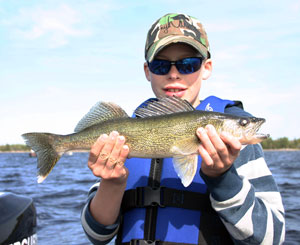Opening day isn’t all about catching fish. Just getting on the water and enjoying what Mother Nature has to offer is part of the opening experience. It’s also a great opportunity to spend quality time with friends and family and maybe even start a new tradition. To that end it still wouldn’t hurt to put a few fish in the boat and can help get your program off to a good start.

David Bley of Cambridge, Minnesota shows why it pays to stick with it.
One thing to keep in mind is the fact that there are always some fish biting somewhere and if you stick with it and keep looking sooner or later you’ll find what you’re looking for. A couple of openers back is a good example and the early results for me and my brother-in-law were less than spectacular. We started the season where we had for the last four or five years and had always done well by slowly drifting a shallow weed bed with a light jig and minnow. But that was then and this was now. Now our starting lead pipe cinch early season program was coming up dry and we finally had to give up on it and look for what we were obviously missing.
What we eventually found was the fact that shallow rocks were holding big schools of fish which were predominantly nice keeper size males that were still milking. A rocky shoreline with a connecting rock covered underwater shelve in the four to eight foot range was the ticket to some incredible action and it didn’t take long to put together a solid catch. Pitching light Northland Tackle Fireball jigs in the 1/16 ounce range tipped with a spot-tail shiner up to the shallowest water was the key to catching fish and not spooking them. Fish would pick up the jig and head for deeper water and you’d have to wait them out and pick up the slack before setting the hook or you’d miss the fish. The shallowest action held until some of the boats drifted over them and moved them out. We then worked the deeper edges of the rocks by slowly drifting the same light jig and minnow and that pattern held for the next three days that we were able to come back. Successful drifts included casting the jig out and away from the boat and then slowly drifting (when there was enough wind) while lifting and dropping the bait. When it calmed down we used the Minn Kota to move slowly and steadily along which allowed us to duplicate the same productive speed and cover some water. Saying on top of our speed was critical, with too fast resulting in baits not staying in the zone and too slow not allowing for a snap forward and drop technique. A productive drift meant picking up and making the same run all over again. Quite often walleyes will turn on in bunches and if you run into a fish or two you better get back before the hot action shuts down. The new I-Pilot from Minn Kota is perfect for retracing productive trolling runs and speeds and does it by taking control of the bow mount electric trolling motor and using G.P.S. to position the boat. It can even hold in you in place( as if you’re anchored), which can keep you’re impact on shallow water fish to a minimum and give you hands and foot free boat control.
Working the night bite is another good early season option and is your best bet for catching big fish. The day bite is typically dominated by smaller males which are perfect if you’re trying to put together enough for a fish fry. Shallow rocky shorelines, bars, and reefs are hot night trolling spots as well as up and coming weed beds. Slowly trolling long slim minnow imitating crank baits like Rapalas and Shad Raps just over the tops of rocks and weeds can be the ticket to big time catches.
Trolling over the tops of walleyes in shallow water without spooking them requires some extra care, especially under calmer conditions. With a hard wind with plenty of wave action you can probably get by using the big motor but flat dead calm might require longer lines and an electric trolling motor. It’s also again where the I-Pilot can really shine. If you have the time; it would be a good idea to get out early and using a depth finder and big motor try to determine a productive trolling path. Once you have it figured out you can save the trail with the I-Pilot. From there you can make that exact same run over and over again with the I-Pilot handling the electric trolling motor which can free you up for more important things like hooking and netting fish. See you on the water.










